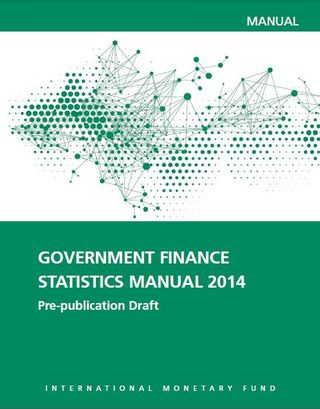Purpose of the Government Finance Statistics Manual 2014 (GFSM 2014)
The GFSM 2014 is an international methodological standard primarily for data compilers to prepare comprehensive government finance statistics “fit for use” for policy analysis. It describes concepts, definitions, accounting rules, classifications, and standard data presentation.
Data users may refer to the Manual to find information on how net debt is defined, measures of debt and deficit, how to record privatization proceeds, contingent liabilities, and other topics relevant to fiscal data.
The GFSM 2014 is the third edition of the IMF’s guidance on fiscal statistics, and it builds on the framework established in the previous edition, GFSM 2001. The Manual is aligned with other macroeconomic manuals, the System of National Accounts 2008 (2008 SNA) and the Balance of Payments and International Investment Manual, sixth edition (BPM6), and others.
The GFSM 2014 is supplemented with the 2011 Public Sector Debt Statistics: A Guide for Compilers and Users (PSDS Guide), the 2013 Quarterly Government Finance Statistics: Guide for Compilers and Users, and the 2011 Compilation Guide for Developing Countries.
Institutional Unit Approach
The GFSM 2014 includes detailed guidance on the delineation of the public sector, the general government sector, and various subsectors (see Figure 1). In line with the 2008 SNA, GFSM 2014 classifies individual entities in the economy into the public or private sector on the basis of control.
Public sector units are either classified as general government units or public corporations. Public corporations include nonfinancial corporations (such as state-owned airlines or utilities) or public financial corporations (the central bank, government-owned banks or other financial institutions).Guidance is also provided on recording data on sovereign wealth funds.
Government Balance Sheets
The GFSM 2014 includes comprehensive definitions of government assets and liabilities. It includes definitions for gross debt and net debt. Gross debt includes all liabilities that are debt instruments including pension liabilities to government employees, andother accounts payable. Gross debt under the GFSM is a broad measure. Fiscal rules such as the European Union’s Maastricht debt often use narrower measures of debt.
Government debt reflects the institutional units and debt instruments as shown in Figure 2.
An Integrated Balance Sheet
The GFSM 2014 integrates stock positions and flows. Transactions and other economic flows (changes in prices, exchange rates, loan write-offs, etc.) are recorded to explain the changes between the opening and closing balance sheet stock positions and to explain changes in government net worth (Figure 3).
Consolidation and Accrual Based Data
The GFSM 2014 emphasizes the presentation of consolidated data, eliminating flows that take place within the government sector or within the public sector. This provides an understanding of the government’s impact on the rest of the economy.
The GFMS 2014 recommends using an accrual basis of recording, in line with the national accounts methodology and commercial accounting, while maintaining data on cash-flows. Cash basis information remains relevant for liquidity analysis. Accrual means transactions are recorded when the economic event occurs whether or not a cash payment is made. Accrual therefore captures future commitments or in-kind transfers which can be substantial.
Key Changes in the GFSM 2014
- Delineation of the public sector – The GFSM 2014 provides more guidance on how to recognize government control over an institution, and how to specify the size and nature of the government / public sector in a country.
- Treatment of military expenditure –The GFSM 2014, consistent with the 2008 SNA,treats spending on these items as capital spending. Previously, government spending on weapons systems was treated as current spending. This will result in a reduction in expense for many countries, and an increase in the acquisition of nonfinancial assets.
- Treatment of tax credits – The GFSM 2014 recommends that payable tax credits are recorded as gross income and gross expenditure. While this change will not impact the deficit (net lending), it will increase both total revenue and total expense.
- Updated guidance on the recording of leases, licenses and concessions - including guidance on the recording of Public Private Partnerships (PPPs).
- Information on the linkages between GFSM and other standards – including the linkages with the SNA 2008 and International Public Sector Accounting Standards (IPSAS).
Transition to GFSM 2014
The IMF provides training and technical assistance to member countries to assist their efforts towards implementation of the GFSM 2014.
About the IMF
The International Monetary Fund (IMF) is an organization of 188 countries, working to foster global monetary cooperation, secure financial stability, facilitate international trade, promote high employment and sustainable economic growth, and reduce poverty around the world. More information about the IMF is available at www.imf.org . For a list of economic statistical standards see: http://unstats.un.org/unsd/.
Data Available at the IMF
Government Finance Statistics are disseminated in the IMF Government Finance Statistics Yearbook, which includes detailed data for about 140 countries.
Country by country information on the structure of government and the International Financial Statistics available at http://www.imf.org/external/data.htm
Acknowledgements
Responsibility for standard setting for Government Finance Statistics lies with the IMF; however, the update of the GFSM 2014 (http://www.imf.org/external/np/sta/gfsm/pdf/text14.pdf)
was a global effort of experts and international institutions. The GFSM 2014 has been prepared by the IMF Statistics Department in close consultation with the Government Finance Statistics Advisory Committee.
Contact
INTERNATIONAL MONETARY FUND
Government Finance Statistics Manual 2014
Note: The posts on the IMF PFM Blog should not be reported as representing the views of the IMF. The views expressed are those of the authors and do not necessarily represent those of the IMF or IMF policy.






